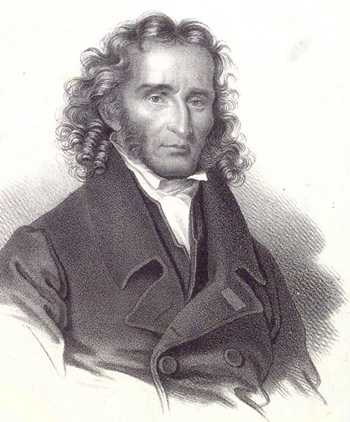
It was 1817 when Niccolò Paganini completed his Twenty-four Caprices for solo violin. Beethoven was forty-seven and at the peak of his career, Schubert was twenty and the seven-year-old Robert Schumann was just starting piano lessons. At the time, the splendidly eccentric Paganini was one of the most celebrated virtuoso violinists in Europe. He always dressed entirely in black for his famous concerts and arrived in a black coach drawn by black horses. He evidently practised fifteen hours every day and always played from memory – a novelty at the time.
The final piece in the set – Caprice No 24 – is a theme and variations and considered one of the most challenging works ever written for solo violin. It requires the use of many advanced techniques such as parallel octaves, rapid shifts and extremely fast scales and arpeggios. There are many other extraordinarily difficult passages, the sight of which would make many a student violinist pass out.
Paganini couldn’t possibly have known that his opening theme from Caprice No 24 would later be borrowed by dozens of other composers as the starting point for variations of their own. Brahms used it in his Variations on a Theme of Paganini and Rachmaninoff used it in his Rhapsody on a Theme of Paganini. There are well over fifty published works which use Paganini’s theme but no one knows the number of unpublished pieces.
Why did Paganini’s melody prove so irresistible to other composers? At first glance the tune seems hardly worth writing home about. It has four bars which are repeated and then eight more bars which are also repeated. The rhythm is identical in almost every bar. Yet the tune has a kind of catchiness and it’s the kind of thing that could jangle in your head all day given half a chance. Perhaps the very simplicity made it attractive to composers and of course, the name Paganini in the title of a work adds a touch of magic and gravitas.
Paganini was not the only composer whose music was borrowed by others. Bach wrote variations on a theme by Frederick the Great (The Musical Offering, since you asked); Brahms wrote variations on a theme by Haydn; Shostakovich wrote variations on a theme by Glinka; Britten wrote variations on a theme by Frank Bridge and Walton wrote variations on a theme by Hindemith. And so the list goes on. There must be hundreds of such works. Usually the main theme is played at the start, followed by contrasting sections that vary some aspect of the initial melody and transform it into something new. Each variation tends to be increasingly elaborate.
Sergei Rachmaninoff (1873-1943): Rhapsody on a Theme of Paganini. Denis Matsuev (pno), State Symphony Orchestra of Russia cond. Leonard Slatkin (Duration: 30:29; Video: 720p HD)
Rachmaninoff avoided the convention of stating the main theme at the beginning and instead merely hints at it. This is a piano concerto in all but name and consists of twenty-four variations on Paganini’s theme. Rachmaninoff wrote it in 1934 and the same year played the solo part at the premiere in Baltimore with the Philadelphia Orchestra under Stokowski. The eighteenth variation, with its echoes of Hollywood romantic movies is by far the best known. The composer must have known that this variation would be popular for he’s reputed to have remarked, “This one’s for my agent.”
The final variation is so technically demanding that even Rachmaninoff expressed trepidation about playing it correctly at the premiere. Before the concert, he broke his usual rule and summoned up some Dutch courage with a glass of crème de menthe to steady his nerves. It worked. The concert was a spectacular success, and before every subsequent performance of the Rhapsody, Rachmaninoff always drank a glass of crème de menthe.
Anton Arensky (1861-1906): Variations on a Theme by Tchaikovsky, Op. 35a. Sydney Conservatorium of Music Chamber Orchestra (Duration: 10:06; Video: 480p)
The letter “a” after the opus number is a clue that this work is an arrangement of something else. In this case, the “something else” was Arensky’s Second String Quartet. The quartet was written in 1894, the year after the death of Tchaikovsky, who had been a significant influence over the younger composer. For the slow movement of his quartet, Arensky borrowed a melody from one of Tchaikovsky’s songs and as a tribute, composed variations on it. At the first performance, the slow movement was so well received that Arensky later arranged it as a separate piece for string orchestra.
When he was eighteen, Arensky moved to St Petersburg with his parents so that he could study composition at the Conservatory. For a time his teacher was Rimsky-Korsakov who didn’t have especially high hopes for him. “He will quickly be forgotten” the great composer tartly remarked. But he wasn’t. Tchaikovsky’s haunting theme is transformed into a wealth of rich and powerful sonorities that reveal Arensky’s composing skill and his unmistakable Russian heritage.
 |
 |
 |





